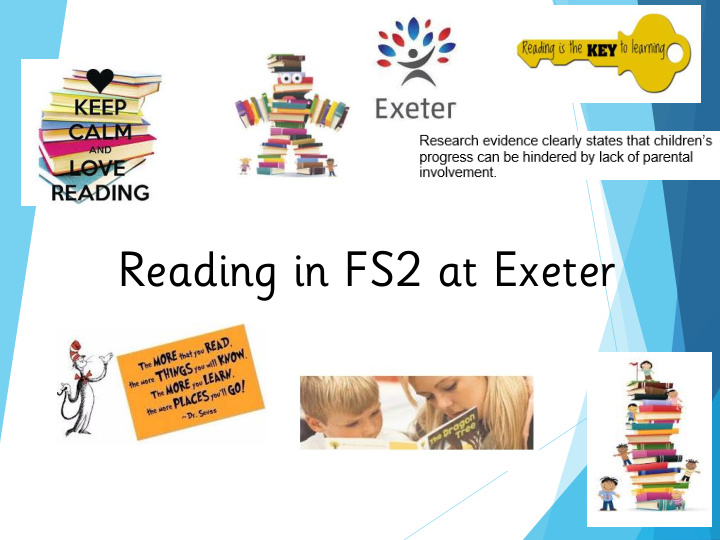



Reading in FS2 at Exeter
What is reading? making meaning of print • more than just matching sounds to a letter •
When does a child learn to read? Readers from birth • Children learn quickly that we communicate • via spoken language Babies are sung to, laughed at, talked to, • listened to Children understand that print conveys • meaning when adults read aloud to them and when they see adults reading.
What makes a skilled and confident reader? Opportunities to: • Build spoken language by talking and listening • Learn about print and books • Learn about the sounds in spoken language (this is called • phonological awareness ) Learn about the letters of the alphabet and how they come • together to form words Listen to books read aloud • Every one of these elements is vital! •
Learn about print and books We use books in certain ways: • Hold them the right way up • Turn pages one at a time • Read L-R • Print Awareness • Print is all around us • Home and outside environment • Environmental Print •
Listening to books read aloud Evidence • ‘Reading aloud to young children is not only one of the • best activities to stimulate language and cognitive skills; it also builds motivation, curiosity and memory.’ Research: more words parents use speaking to 8 month • old infant, greater size of child’s vocabulary at age 3. Research suggests that reading aloud helps children • build a stronger foundation for school success.
Engagement and Enjoyment What is a literacy rich environment? • How many different types of print are on offer at home ? • menus chapter books cards food newspapers emails non-fiction packets picture books magazines catalogues recipe books letters atlases shopping lists programmes comics poetry
Literacy rich home environment • Environment is the total impact of conditions, influences and surroundings on children. • Children who grow up in homes where reading is valued do better at school.
How? You don’t need a book. Establish a regular time (before bed/bath time works • Use teddies as puppets well) and create or retell a Keep a large variety of reading materials at hand • story. This will develops Store books/materials in places children can access • your children's Get library cards for whole family • imaginations and story Share your love of books with them/advertise the joy of • telling greatly. reading! Have paper and writing tools available along side • Model reading and writing for pleasure • Make time for conversations about books and reading • Use board games to reinforce language/literacy skills •
Engaging your child – making it fun ! Join the library • Build a home library • Let your child choose the book • Use funny voices! • Tap into their interests • Take books with you on journeys or shopping • trips Use technology to your advantage •
Supporting your child with reading Reading at Exeter Nursery • Children begin Letters and Sounds Phase 1 • Teaches children to tune into and discriminate sounds • Has 7 aspects covering: environmental sounds, • instrumental sounds, body percussion, rhythm and rhyme, alliteration, voice sounds and oral blending and segmenting
Can you show me the words? Discuss the meaning of vocabulary- Which way do we read? we should never presume they know what a word is.
Characters Main character Good or bad How can we describe the characters? Do you know any more Setting stories about bears? Where? What is it like there? Do you know any other Retell the story with puppets/props-story baskets stories with the same setting? ‘ Read’ the story to a friend using the pictures as prompts .
FANTASTIC Feeling Touching Action Noticing Asking Imagining Smelling Checking Tasting
Supporting your child with reading Reception Children each have a reading day once a week • Adult supports child selection of appropriately leveled book to support specific • aspects of their reading development – banded book Read 1:1 with Class Teacher or TA • Phonics : We follow the Read Write Inc Scheme. Children in Reception have been • learning Set 1 sounds. Banded books are decodable so allow children to practice segmenting a word • by saying the pure sounds and then blending it back together.
Phonics Necessary – but not the only skill needed • 30 minute sessions daily for all children • Children are set in ability groups to help focus • teaching Short sharp sounds ‘b’ not ‘ buh ’ ‘h’ not ‘huh’ • etc Reading rambles are sent home weekly to • consolidate the sounds and words the children are working on that week.
Supporting your child with reading Use phonics first • Play games – flashcards can help with unfamiliar vocabulary • or ‘tricky words’ (cannot be worked out by sounding out e.g said) Use ‘book talk’ – talk about stories and story language, key • features of the book, word level – words, sentences, punctuation, features on the page e.g. speech bubbles Check understanding – encourage use of picture clues to help • understanding, also show your child how you might be able to predict the meaning from other word clues. Use question prompts to help deepen your child’s • understanding and support their reading development Model • Read in your home language! •
Supporting your child with reading Extra tips: • Turn of the TV • Read when you are out and about – road signs, timetables, • billboards Play games • Sing songs and rhymes • Tongue twisters • Read and recite poetry • TALK TALK TALK! •
Supporting your child with reading • Phonicsplay.com • Cbeebies bedtime stories • Geraldine the Giraffe on YouTube. • App on IPhone/Android – free on computers/ laptops
Any Questions:
Recommend
More recommend